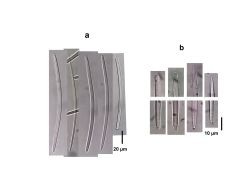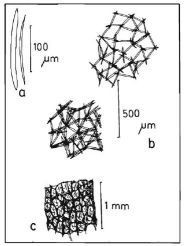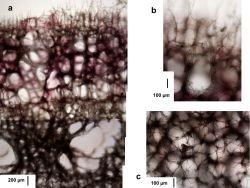yellow
brown
cinnamon-tan
branching
hard
Bahamas
Colombia
Neopetrosia subtriangularis
Description: Cylindrical branches, repent or erect, 1 to 5 cm in diameter, often dividing dicho-, tricho- or poly-tomously, reaching 50 cm or more in size and height; erect branches tend to grow inclined, staghorn-like. Oscules usually aligned on top of branches, 0.5-2 cm in diameter, flush but often with a thin, perpendicular and lighter collar, or on top of conical, volcano-like elevations, the latter up to 2-3 cm high. Color light yellowish brown, cinnamon-tan or yellow; growing tips lighter; internal color cream. Consistency hard, somewhat difficult to break or cut in thicker specimens, but easier in thinner ones, which are more brittle. The choanosome is dense, but for the exhalant canals that reach the oscules. Skeleton as rather regular reticulation of ascending and interconnecting thick mustispicular spicule tracts, 30-70 µm thick, forming rounded to elongated and rectangular meshes, 100-400 µm in diameter. At the surface the tracts are thinner, uni to paucispicular, ending in erect spicules interconnected at the base by a tangential, unispicular reticulation of triangular meshes. In perpendicular sections layers of growth can be seen with different track thickness and elongation of the meshes. In deeper parts there are quite a few spicules strewn in confusion in between meshes. Spicules are hastate oxea, slightly curved, thinner in developmental stages, with blunt to mammiform or irregular endings, 120-178 µm long by 2.5-5.5 µm wide; southern Colombian spicules have slightly longer and thicker sizes, 131-181 x 1.6-11.7 µm.
Notes: This is a rocky shore and shallow to deep reef species, living exposed, but can also be found growing near mangrove roots. The species was originally described under the genus Spongia, and then included under Thalysias, Haliclona and Xestospongia; Haliclona doria de Laubenfels, 1936, and Haliclona longleyi de Laubenfels, 1932, are junior synonyms (see van Soest, 1984 and the WPD, but see argument in Desqueyroux-Faúndez & Valentine, 2002). Its branching growth forms is unmistakable among other Neopetrosia and Xestospongia species pictured here, although it can be confused with branching N. proxima; the sticky texture of cut surfaces of the latter, and a more confused and fascicular arrangement of the skeleton are characteristic of the latter.
Author Reference: (Duchassaing, 1850)
Link: World Porifera Database

![<i>Neopetrosia subtriangularis</i> <br />[Colombia, Islas del Rosario]](mini/00117/02041.jpg)
![<i>Neopetrosia subtriangularis</i> <br />[Colombia, Islas del Rosario]](mini/00117/02042.jpg)
![<i>Neopetrosia subtriangularis</i> <br />[Colombia, Islas del Rosario]](mini/00117/02043.jpg)
![<i>Neopetrosia subtriangularis</i> <br />[Colombia, Islas del Rosario]](mini/00117/02047.jpg)
![<i>Neopetrosia subtriangularis</i> <br />[Colombia, Islas del Rosario]](mini/00117/02048.jpg)


